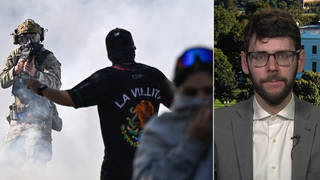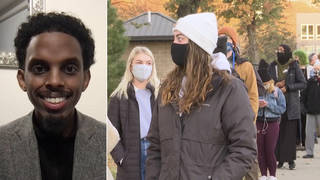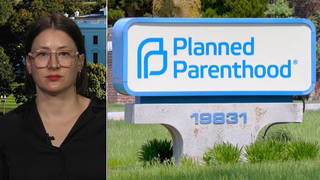
Topics
The Supreme Court heard oral arguments Wednesday in the most significant abortion case in a generation. Abortion providers in Texas, led by Whole Woman’s Health, have challenged provisions of a sweeping anti-choice law passed by the Texas state Legislature in 2013 despite a people’s filibuster and an 11-hour stand by Texas state Senator Wendy Davis. The provisions at stake force abortion clinics to meet the standards of hospital-style surgery centers and require providers to obtain admitting privileges at a nearby hospital—a task many can’t achieve, in part due to anti-choice sentiment. Similar restrictions have been passed in multiple states. As the case was being argued inside the court, a few thousand people rallied outside in support of Whole Woman’s Health, including fellow abortion providers and women who have had abortions. Democracy Now!’s Amy Littlefield was at the rally and also spoke with the anti-choice protesters, who held a competing demonstration.
Transcript
AMY LITTLEFIELD: Today, the Supreme Court is hearing the most important abortion rights case in almost 25 years. We’re here in front of the Center for Reproductive Rights in New York City. That’s the organization that’s arguing the case before the Supreme Court today. It’s about 3:45 in the morning. It’s dark. It’s raining. And we’re about to get on a bus with a bunch of activists who are headed down to D.C. to rally in front of the Supreme Court and show their support for abortion rights. Let’s get on the bus.
What’s your name, and what are you doing on this bus at 4:00 in the morning?
DR. MONICA DRAGOMAN: Hi. I’m Monica Dragoman. I am a woman. I am an obstetrician/gynecologist, and I also am an abortion provider. And I’m here because I support women’s ability to self-determine and decide when and if they want to have a family. And it’s a privilege to do the work that I do. It’s a privilege to take care of the women that I interact with. And there’s really no more important place to be today than on this bus.
AMY LITTLEFIELD: So it’s about four hours later. We’re still on the bus headed into D.C., and everyone’s getting ready to rally.
ORGANIZER: Repro rights are under attack. What do we do? Stand up! Fight back! Repro rights are under attack. What do we do?
BUS RIDERS: Stand up! Fight back!
AMY LITTLEFIELD: So we’ve arrived here in Washington, D.C. We’ve gotten off the bus, and we’re heading over to the Supreme Court.
PRO-CHOICE PROTESTERS: Stop the sham! Stop the sham! Stop the sham!
SONYA RENEE TAYLOR: What’s up, y’all? Are you on fire today? My name is Sonya Renee Taylor. I am a performance poet, an activist and an unapologetic woman who has had an abortion. Let me say that again: I am an unapologetic woman who has had an abortion. I was a 20-year-old college sophomore putting myself through school when I got pregnant. I reject the narrative that there must be some externally decided, good enough reason for any of us to access safe, legal, professional, compassionate abortion care and services. I do not owe the Texas Legislature, anti-choice fearmongers or even the Supreme Court of the United States any explanation as to why I had an abortion.
AMY LITTLEFIELD: Next up is Andrea Ferrigno, corporate vice president at Whole Woman’s Health, the lead plaintiff in the abortion case.
ANDREA FERRIGNO: I am so thankful. For so long, we’ve felt, as providers, so alone. And to see all of you here come bear witness as we bring our case to the Supreme Court is just unbelievable. Thank you. Thank you. As a Hispanic immigrant from Latin America, I know what it’s like not to have access to safe, legal abortion care, in an environment where women’s voices matter. This is why this work is so important for me on both a professional and personal level. But I have also witnessed firsthand how laws like HB 2 can force clinics to shut down. I think about the woman on the phone that begged me to see her after our clinic was shut down by this law, and I still remember the desperation in her voice when she said, “Please, please, just see me. I won’t tell anyone. Why can’t you just see me? Please,” and not having a logical answer to her because there’s no logic behind this.
AMY LITTLEFIELD: Could you say your full name and where you’re from?
ROSE BARNES-COVENANT: My name is Rose Barnes-Covenant, and I’m from Washington, D.C. Our generation has spent a lot of time thinking that progress has been made, and it’s being taken from us. And if we don’t stand up now, we’re not going to have a choice. There are a lot of women here that did this work in the '70s, and I think my generation thinks this is old news. And now we're slowly seeing an erosion of our rights, where it’s harder to fight if they take it piece by piece. And it’s finally gotten to a point where people have to stand up. And if not, we’ll just—we’ll go back to the ’60s.
PRO-CHOICE PROTESTERS: Stop the sham! Stop the sham! Stop the sham!
UNIDENTIFIED: Springfield, Virginia.
AMY LITTLEFIELD: And why are you here today?
UNIDENTIFIED: I’m here because in the '70s and the ’80s, when I had to worry about my reproductive health, I was able to do so. I don't think it’s right for people who have a lot of money to be able to fly to a different state to get abortion access. It’s all about access. I had access. These girls should have access. I can’t believe we’re still fighting this.
DR. SARA IMERSHEIN: My name is Dr. Sara Imershein, and I am an abortion provider. I performed my first abortion as a routine procedure in 1980 during my internship at New York’s Bellevue Hospital. My professors, my mentors remembered wards filled with injured and infected women and the many women who died before abortion was legal and available. We must not forget their stories or their lives, and we must remember: Women will seek abortion even when it is illegal. Abortion is medical, not political. Abortion is medical, not political!
BRENDA PEARL: My name is Brenda Pearl. I’m an activist, I’m an African American, and I am a woman. And I’m a student from Ohio. And I’m here to share my story. In the summer of 2014, I became pregnant. I was planning to continue my studies that fall. And having a baby at that time in my life would have derailed my plans and goals. I had just enough money for books, with not a cent more. I also had life—I also had a life path in front of me, a path I longed to follow. For that reason, I chose to have an abortion. It was one of the hardest decisions I ever made, but in the end it was a decision to determine the fate of my life.
The state of Ohio makes it very difficult for women to access safe, legal abortion. First you have to schedule an appointment to receive state-mandated information. It’s misleading information that is meant to discourage you from having the abortion that is your constitutional right. They also make you have an ultrasound, even after you already probably had an ultrasound. It was painful to feel I was pressured to listen to the heartbeat. Then you have to wait 24 hours to come back, and the procedure itself. Personally, the biggest obstacle was paying for the abortion. Except in extreme cases, you have to pay for it yourself. I am sharing my story with you today to raise my voice about the protection of safe, legal abortions, and also about truth, free will, healing and freedom. Thank you.
AMY LITTLEFIELD: So, we’re here on the border between the pro-choice and the anti-choice sides right outside the Supreme Court. On one side are the pro-choice activists, and on the other side are the anti-choice activists. They have two competing rallies here. Let’s talk to some of the people on the anti-choice side.
KRISTAN HAWKINS: Kristan Hawkins. I’m the president of Students for Life of America.
AMY LITTLEFIELD: And why are you here today?
KRISTAN HAWKINS: I’m here today because we want to show the justices that this is a pro-life generation. Majority of Americans agree with our side, and the majority of Americans agree with the commonsense safety regulations in HB 2.
AMY LITTLEFIELD: I saw some research recently, though, that seven in 10 women—or seven in 10 people are on the pro-choice side. What makes you say that you have more people on your side?
KRISTAN HAWKINS: When you look at the polling and you actually ask people on the issues, we have the majority. We don’t use labels—pro-life, pro-choice. Most millennials are like, “I don’t want to be labeled. I don’t even understand what the labels mean.” When you ask people, “When do you think abortion should be legal? Under what circumstances should be—abortion should be legal?” we’re winning all day long.
TROY NEWMAN: I’m Troy Newman. I’m the president of Operation Rescue.
AMY LITTLEFIELD: And what are you doing here today at the Supreme Court?
TROY NEWMAN: Well, we’re praying, number one, that the court is going to uphold the Texas law, HB 2. And number two, we’re testifying to the fact that women die inside abortion clinics. This is commonsense regulation. I want to see abortion ended today, but this is commonsense regulation that’s going to make sure that women are given the best and most proper healthcare.
AMY LITTLEFIELD: Will these laws in Texas help to achieve your goal of ending abortion?
TROY NEWMAN: Well, yes, because abortionists simply cannot or will not rise to the level of being a normal physician. You don’t—you don’t come out of medical school, by and large, and say, “I want to become an abortionist.” You sink to the level of being an abortionist. It’s so commonsense. To see these people so completely angry is—they’re off their rocker.
AMY LITTLEFIELD: Although it sounds like you might agree with one thing on the pro-choice side, which is that these laws are ultimately threatening to and perhaps aimed at ending abortion, right?
TROY NEWMAN: I will. I will do anything to—I will do anything safe, legal and moral to end the child killing. And you know what that does? It saves women’s lives, and it saves babies’ lives. These ghouls over here are chanting to kill more babies. I find that repugnant and disgusting.
AMY LITTLEFIELD: Troy Newman, you’ve been criticized in the past for some of your tactics. Some people have even gone so far as to call you a domestic terrorist and to say that you’ve called for the murder of abortion providers.
TROY NEWMAN: Yeah.
AMY LITTLEFIELD: Is that true?
TROY NEWMAN: Yeah, it’s ridiculous. If any of that were true, I wouldn’t be able to stand here.
AMY LITTLEFIELD: One more question. One in three women will have an abortion by age 45.
TROY NEWMAN: Yeah.
AMY LITTLEFIELD: What happens to those women if abortion becomes inaccessible in the United States?
TROY NEWMAN: Imagine this: They have a beautiful baby.
ANTI-CHOICE PROTESTERS: No more Roe! No more Roe!
NAVYA KUMAR: I’m Navya Ravi Kumar. I’m from Austin, Texas. OK, that’s weird. You take—
AMY LITTLEFIELD: What’s happening right now, can I just describe it? We’re right here on the border between the pro-choice and anti-choice side, and there is a sign that’s being—someone is putting behind you.
NAVYA KUMAR: Yeah, I mean, this, in itself, is problematic, because that’s not a fetus. That’s a literal baby, and it’s like three months old. So, that doesn’t even make any sense.
AMY LITTLEFIELD: You’re talking about the picture on the sign.
NAVYA KUMAR: Yeah.
AMY LITTLEFIELD: Do you have a response to that? She says that what’s on your sign is not a fetus, it’s a baby.
ANTI-CHOICE PROTESTER: We don’t discriminate of people based on their looks or their age or their location. We love babies. Every child has to be cared for and fed, no matter where they’re located. That’s why we love.
NAVYA KUMAR: That wasn’t the argument, but OK. The argument was that they are talking about aborting fetuses. Fetuses are not babies. Babies are born. That’s the definition of a baby. But we learn that in eighth grade science, so that’s good.
AMY LITTLEFIELD: Do you have a response to that?
ANTI-CHOICE PROTESTER: This is a female. We love females. We protect females, whether they’re in the womb or not. We don’t believe that promiscuous sex gives you a right to kill. You can have as much promiscuous sex as you want, but we don’t kill.
NAVYA KUMAR: Thanks for giving me the right to have sex. I didn’t know that you controlled my body. So, thanks for that.
SONYA RENEE TAYLOR: Are you ready for the next speaker? Dr. Valerie Peterson!
DR. VALERIE PETERSON: I found myself pregnant in July of 2015. And while it was an unplanned pregnancy, it was a very wanted pregnancy. I wanted to have my baby. So you know what I did? I do what women are supposed to do: We go get prenatal care. And I started getting prenatal care for my baby.
But soon after I started getting the prenatal care, the doctors thought that something was wrong with the fetus. So, at 16 weeks, my son received the diagnosis of alobar holoprosencephaly, which means that his brain did not fully develop. My son had half a brain. My doctor told me I had two choices: I could continue to carry the pregnancy, or I could terminate the pregnancy because it was 100 percent incompatible with life.
I live in Austin. And I say, “You know what? Doc, hey, can we take care of this right now?” And the doctor said, “No, unfortunately, because of the Texas laws, you have to go to Planned Parenthood or another provider.” And, boy, was I emotionally distraught, was I mentally distraught. I broke down crying. I didn’t know what to do. And I also found out that it was a multiple-day process that I would have to go through.
Knowing that my baby was 100 percent not viable, eventually, you know what I did? I flew to Florida. I flew to Orlando the next day. I couldn’t take the emotional pain. I couldn’t wait another day. And had I not had the resources, I don’t know if I would be here talking to you today.
AMY LITTLEFIELD: Next up at the podium is Dr. Willie Parker, who provides abortions in the South. And it looks like he’s wearing a purple hat with an emblem of a golden uterus on it.
DR. WILLIE PARKER: Hey, I flew in last evening from Jackson, Mississippi, where I saw people, women at the Pink House, the last clinic in Mississippi. Yesterday I saw a woman from Louisiana who—now that state will only have one clinic because of recent changes in the law. But she came to Jackson because that was the closest clinic to her. I told her that I would be here today, and she told me that she works as a health administrator in an ER, that they were seeing women there with complications from do-it-yourself medications on the Internet. And when I told her that I was going to be here, she said, “You make sure that you tell them up there what’s happening down here.” So I’m keeping my word to her.
America, we have a problem. But don’t worry, there’s a doctor in the house, 'cause today I'm going to diagnose that problem for you, and I’m going to make some treatment recommendations. I spent the last 25 years of my career figuring out the problems of women’s health. So when I put my medical hat on—this is not my medical hat—and I look at women’s health in this country, it seems to me that we have an epidemic of invasive political conservatitis. Now, “What is that?” you might ask. Political conservatitis is where the bodies of reproductive-age women in this country are being invaded by a species of conservative politics, where politicians are in places making rules about things that they don’t know anything about.
AMY LITTLEFIELD: So, here are these two dueling rallies at the Supreme Court. While Dr. Willie Parker was speaking at the pro-choice rally just several yards away right here in front of the Supreme Court, House Speaker Paul Ryan suddenly emerged from the court building and addressed the rally here.
SPEAKER PAUL RYAN: It is great to see you. We are the pro-life movement, and we are here. And we are the pro-life movement and here to stand up for the women. We are here to stand up for the unborn. And we are here to stand up for the rule of law. We are here to defend Texas.
PRO-CHOICE PROTESTERS: Stop the sham! Stop the sham! Stop the sham!
NANCY NORTHUP: And now, our final speaker at this rally to close us out today. When you start a lawsuit, it takes a brave person to step forward. I am so proud to now introduce Amy Hagstrom Miller, who’s the CEO of Whole Woman’s Health.
AMY HAGSTROM MILLER: So, just look at all of you. Many of you took off work. You got on buses from all across the country. You arranged child care. And some of us have even brought our kids along. And you’ve come here in the cold to stand united for abortion access. Thank you for making the journey. But here’s the sad part. However far you traveled, however tough it was, for most of you, coming here today was nothing compared to what a woman in Texas goes through to get an abortion.
I dream of a world where no one comes into my clinics thinking that they are the only person they know who has had an abortion, thinking that they are the only Christian that has had an abortion, thinking that they are the only good mother who has had an abortion.
We stand in opposition to HB 2 and any law like it that shuts down clinics, forces women to delay care and creates obstacles to abortion. But we also stand for something. We stand here to affirm that women are good. We stand to affirm that women are moral and kind, to affirm that when a woman has decided to end a pregnancy, we can witness her dreams and her aspirations and affirm that she is put on this Earth to see them out and act on her own gifts. That is the world we stand for, and that is the world we will create together. Thank you.












Media Options